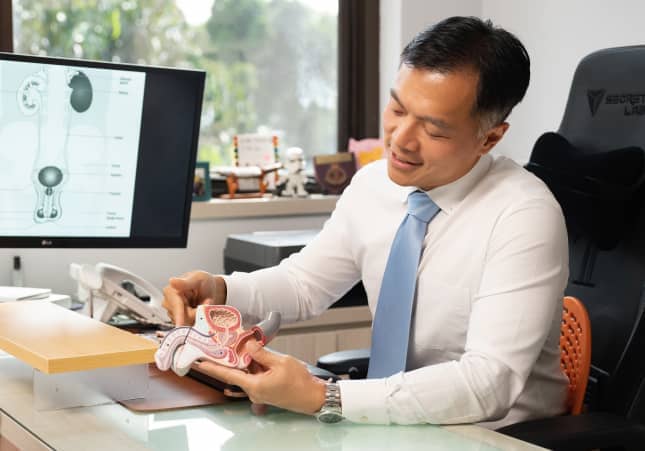Transperineal Targeted Prostate Biopsy

Prostate Biopsy
A prostate biopsy is a procedure to remove tissue samples from the prostate to diagnose cancer. Your urologist may recommend a prostate biopsy if results from initial tests suggest you may have prostate cancer.
Tissue samples from the prostate biopsy are examined under a microscope for cell abnormalities that are a sign of prostate cancer. If cancer is present, it is evaluated to determine its character and the speed it's likely to progress and to determine your best treatment options.
Types of prostate biopsy procedures
Transrectal
The needle is passed through the wall of the rectum. This is the conventional way of performing a prostate biopsy.
Transperineal (New)
The needle is inserted through the area of skin between the anus and scrotum. A small cut is made in the area of skin (perineum) between the anus and the scrotum. The biopsy needle is inserted through the cut and into the prostate to draw out a sample of tissue. This new method offers minimal risk and discomfort as compared to the traditional transrectal method.
Transrectal Biopsy vs Transperineal Prostate Biopsy
Watch the this summary video that helps explain what prostate biopsies are and their differences.
A Safer & Sterile Solution: The Transperineal Targeted Prostate Biopsy
As one of the first healthcare providers in Singapore and Southeast Asia to offer the transperineal targeted prostate biopsy, Tan Urology is pleased to provide patients with a new and improved way of conducting prostate biopsies, one that is:
- Safer & CleanerMinimal risk of infection
- No AntibioticsReduces the chance of bacteria building up antibiotic resistance
- More PreciseAccurately guided by real-time ultrasound and MRI
- More ComfortableLocal anaesthesia and sedation are used
- More ConvenientHospitalization and general anaesthesia are not required
- No rectal bleedingNo needle punctures of the rectum done


Comparing the New Transperineal & Traditional Transrectal Methods
In the new transperineal method, the biopsy needle will be accurately guided through the perineum to reach the prostate and obtain a tissue sample. This is unlike the traditional transrectal method, where the needle goes through the rectum to reach the prostate; carrying an inherent risk of transmitting faecal bacteria into the prostate and placing the patient at risk of a potentially serious infection.
To combat the risk of infection, antibiotics are routinely administered before and after a traditional transrectal biopsy. However, this is obviously not ideal, and have also led to a worrying trend of increasing antibiotic resistance. With the new transperineal method, the risk of infection is negligible, thus there is no need for antibiotics—a more convenient and healthier option.
Additional Feature: More Powerful Imaging Technology
Areas suspicious for prostate cancer can be seen on MRI. Our upgraded biopsy platform overlays MRI data onto real-time ultrasound images to create a fused 3D model of the prostate. Regions deemed suspicious for cancer are displayed prominently within the live MRI-Ultrasound model to guide accurate placement of the biopsy needles. In contrast, the standard transrectal biopsy is a blind sampling of the prostate, as suspicious areas for cancer cannot be seen on ultrasound alone.

MRI showing area suspicious for prostate cancer outlined in green. Prostate is outlined in pink.

Blue outline is target from MRI superimposed onto real-time ultrasound. Yellow line shows path of biopsy needle placed through the target.

3D model of the prostate recorded at the end of the biopsy. The yellow and green areas are suspicious areas for cancer. The red rods shows the path of the biopsy needles going through these targets, confirming accurate sampling.






